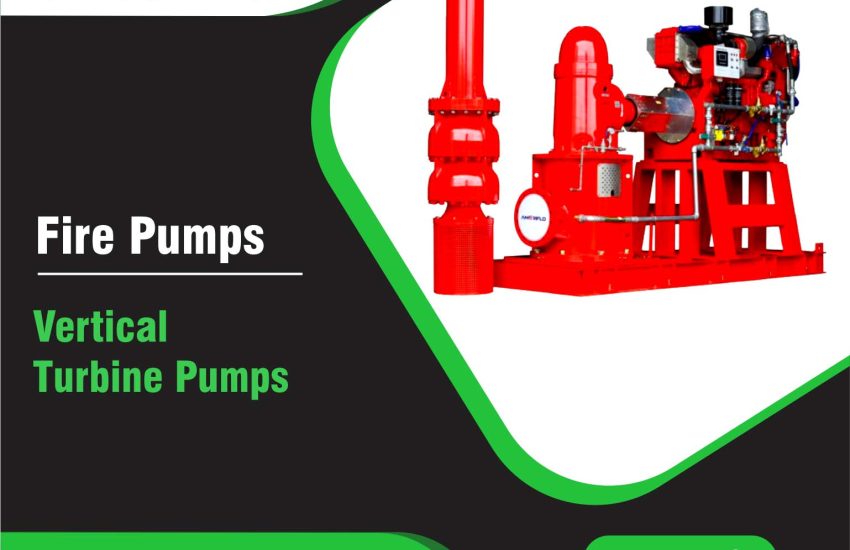Vertical Turbine Pumps are essential for various pumping applications, particularly in industries like water treatment, irrigation, and municipal water systems. These pumps excel in deep wells and large tanks, making them ideal for projects requiring high pressure or significant lift. In this article, we will examine the specifications, features, and diverse applications of vertical turbine pumps.
What Are Vertical Turbine Pumps?
A vertical turbine pump (VTP) is a type of centrifugal pump with an axial flow design. It works by lifting water from deep wells or vertical systems using a vertical shaft that connects the pump bowl assembly to the motor located above. These pumps provide an excellent choice for applications where space is limited and high-capacity water lifting is necessary.
Key Specifications of Vertical Turbine Pumps
Vertical turbine pumps come in many sizes and configurations. Here are the critical specifications that define their performance and suitability for various applications.
Flow Rate
The flow rate of a vertical turbine pump is one of the most important performance metrics. Typically, the flow rate ranges from 50 to 20,000 gallons per minute (GPM). This rate indicates how much liquid the pump can move within a given period and helps determine the pump’s capacity for different tasks.
Head (Pressure)
Head refers to the vertical lift capacity of the pump. Vertical turbine pumps are particularly suited for generating high pressure. Depending on the pump’s design, the head pressure can range from 100 feet to more than 1,000 feet. This capability makes them ideal for applications requiring deep water lifting or high-pressure water delivery.
Motor Power
Motor power varies depending on the size and purpose of the vertical turbine pump. Smaller pumps can operate with fractional horsepower (HP), while larger pumps used for industrial applications may require several thousand HP. A higher motor power allows the pump to handle more demanding flow rates and pressures.
Suction and Discharge Sizes
The suction and discharge sizes determine how effectively the pump integrates into a system. Typically, the suction side needs to be larger to accommodate water being drawn from deep wells. The discharge size can range from 2 inches to over 12 inches, based on the pump’s flow rate and the system’s requirements.
Material Construction
Vertical turbine pumps use corrosion-resistant materials such as stainless steel, bronze, and various alloys. These materials help the pump withstand harsh environmental conditions and chemicals, ensuring its longevity and effective performance over time.
Efficiency
Vertical turbine pumps are designed to operate with high efficiency, often achieving efficiency levels of 85-90%. Their efficient design reduces energy consumption while ensuring optimal performance, which is crucial for long-term operation and cost-effectiveness.
Pump Bowl Assembly
The pump bowl assembly houses the impellers and helps generate the pressure and flow. The number of stages in the assembly can vary, typically ranging from 2 to 10 stages, depending on the desired flow rate and head pressure. Each stage contributes to lifting water and circulating it through the system.
Pump Shaft and Shaft Sleeves
The pump shaft transmits power from the motor to the impeller. To protect the shaft from wear and tear, manufacturers often use shaft sleeves. These components reduce friction and protect the shaft from damage, which ensures the pump operates smoothly and lasts longer.
Motor Type and Configuration
Vertical turbine pumps can be powered by either electric motors or internal combustion engines. Users most commonly choose electric motors when energy is readily available. They place the motor above the pump, which allows the system to remain compact and efficient.
Bearings and Shaft Sleeves
Bearings play a key role in supporting the pump shaft, reducing friction, and ensuring smooth operation. Together with shaft sleeves, they reduce wear, helping the pump maintain its efficiency and reliability over time.
Applications of Vertical Turbine Pumps
Vertical turbine pumps are versatile and widely used in various industries. Below are some key applications:
- Agriculture: These pumps are essential for irrigation systems, where they lift water from deep wells or reservoirs to irrigate crops efficiently.
- Municipal Water Systems: Vertical turbine pump provide reliable water supply by drawing water from deep groundwater sources and delivering it to cities and towns.
- Industrial Applications: Chemical plants, refineries, and power stations use these pumps to circulate liquids, move cooling water, or handle large volumes of fluids.
- Water Treatment Plants: These pumps are integral to water treatment processes, ensuring that water circulates effectively through filtration and purification systems.
- Mining: Vertical turbine pumps are used to remove groundwater from deep mines, making it easier for workers to extract materials from lower levels.
Advantages of Vertical Turbine Pumps
Vertical turbine pump offer several significant benefits that make them an excellent choice for a variety of applications:
- Space-Saving Design: Their vertical configuration allows for minimal floor space usage, making them ideal for installations in areas with limited space, such as deep wells.
- High Efficiency: These pumps operate efficiently, reducing energy consumption while maintaining optimal performance.
- Durability: Made with corrosion-resistant materials, vertical turbine pump withstand challenging conditions, ensuring long-term reliability.
- Versatility: These pumps can handle various flow rates, head pressures, and types of liquids, making them suitable for many different industries and applications.
- Ease of Maintenance: The vertical turbine pump design allows for easy access to components for maintenance, minimizing downtime and repair costs.
Conclusion
Vertical turbine pumps are essential tools for applications requiring high flow rates, significant pressure, and deep water lifting. Their robust design, energy efficiency, and space-saving configuration make them ideal for industries like agriculture, municipal water systems, and industrial processes. By understanding the specifications of vertical turbine pump, you can select the best option for your needs, ensuring reliable performance and long-lasting efficiency.


